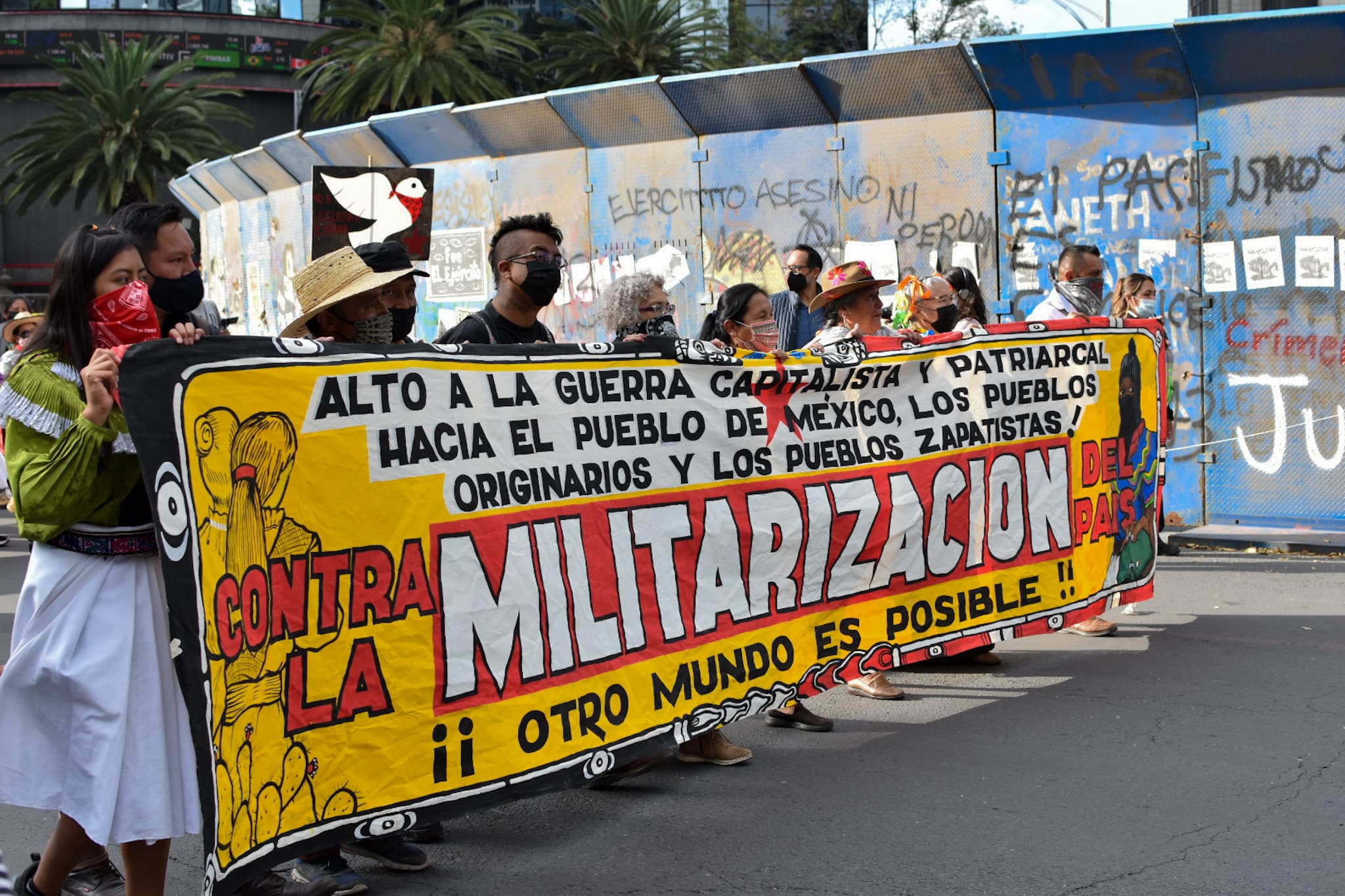
Snapshot of a War Against People and Nature: A Chronicle from Mexico
In PerspectiveIn 2006, the former right-wing Mexican president, Felipe Calderón, decided to formalise a war on drugs to boost the economy and, thus, legitimate the new government after he defeated the progressive candidate, Andrés Manuel López Obrador, in a controversial election. Since then, the country has been exposed to terror of every type, with an increase in the trafficking of drugs, guns, and human beings, while assaults, extorsion, dispossession, displacement, kidnapping, shootings, torture, bombings, narco blockades, disappearances, femicides, murders, and massacres have all become part of daily life
"In many tongues, languages, and gestures, we name those who are not among us.And every pain and rage takes on a name, a face, a history, a void that hurts and infuriates.The world and its history are thus filled with absences, absences that murmur, speak, yell, cry out. We do not scream out of grief. We do not cry out of sorrow. We do not murmur in resignation.Our voice is so that those who are absent find the path of return.
So that they know that they are here even though they are absent.
So that they do not forget that they are not forgotten.
Because of this: for pain, for rage, for truth, for justice"
Subcomandante Insurgente Moisés and Subcomandante Insurgente Galeano, 2015
In 2006, the former right-wing Mexican president, Felipe Calderón, decided to formalise a war on drugs to boost the economy and, thus, legitimate the new government after he defeated the progressive candidate, Andrés Manuel López Obrador, in a controversial election. Since then, the country has been exposed to terror of every type, with an increase in the trafficking of drugs, guns, and human beings, while assaults, extorsion, dispossession, displacement, kidnapping, shootings, torture, bombings, narco blockades, disappearances, femicides, murders, and massacres have all become part of daily life. Authorities of different political complexions have justified the situation by saying “they only kill each other”, leading society to normalise violence and fear. In 2018, López Obrador competed in the presidential elections for the third time, promising to end the war by radically changing the country’s security strategy. After one of the most violent elections in recent history (1), many people voted for López Obrador because he represented a way out of the situation, deadly as it had become. But has the new government been able to achieve peace?
An unceasing war
Once in power, the new government began breaking its promises. In 2019, the president created the National Guard, a “peace police” in charge of public security, peace restoration, and the fight against crime. Rather than becoming enshrined as a civil institution, however, it became a new military force. It began its new role by repressing caravans of Central American and Caribbean migrants who dreamt of reaching a better life in the United States. During the pandemic, the government even increased the budget of the armed forces, affording it greater powers while imposing a series of austerity measures that affected public health, human rights, education, science, and art. Although Mexico did not enforce a curfew, militarisation spread, with the armed forces controlling COVID-19 vaccines and incurring into new realms of everyday life such as banking, transportation, and social programs.
History has shown that military coups do not always involve taking the government by force. As has been shown by a WOLA report, the armed forces in Mexico have reached such extreme levels of influence that a coup is no longer necessary for them to exercise high levels of power. The question, as such, is how has this military strategy changed the violent panorama in Mexico? According to official figures, there have been over 430,000 homicides and 95,000 missing persons in the past 17 years. Of these crimes, 33 percent and 46 percent respectively (2) have been committed during the López Obrador administration. Even if these records can be compared to those of a civil war, they do not show the pain of people seeking their loved ones, those who excavate throughout the country finding clandestine graves, who demand truth and justice for these crimes, who transform public spaces into anti-monuments. It does not reflect the fear and rage people experience when they are stopped at a cartel checkpoint, when mines explode in their neighbourhoods, when heads hang on pedestrian bridges, when those defending the community are found dead, when children are recruited as sicarios, or when cartel take over cities. Violence and insecurity remain the public’s central concern and, increasingly, people feel their voices are going increasingly unheard in the face of rampant corruption and impunity. (3)
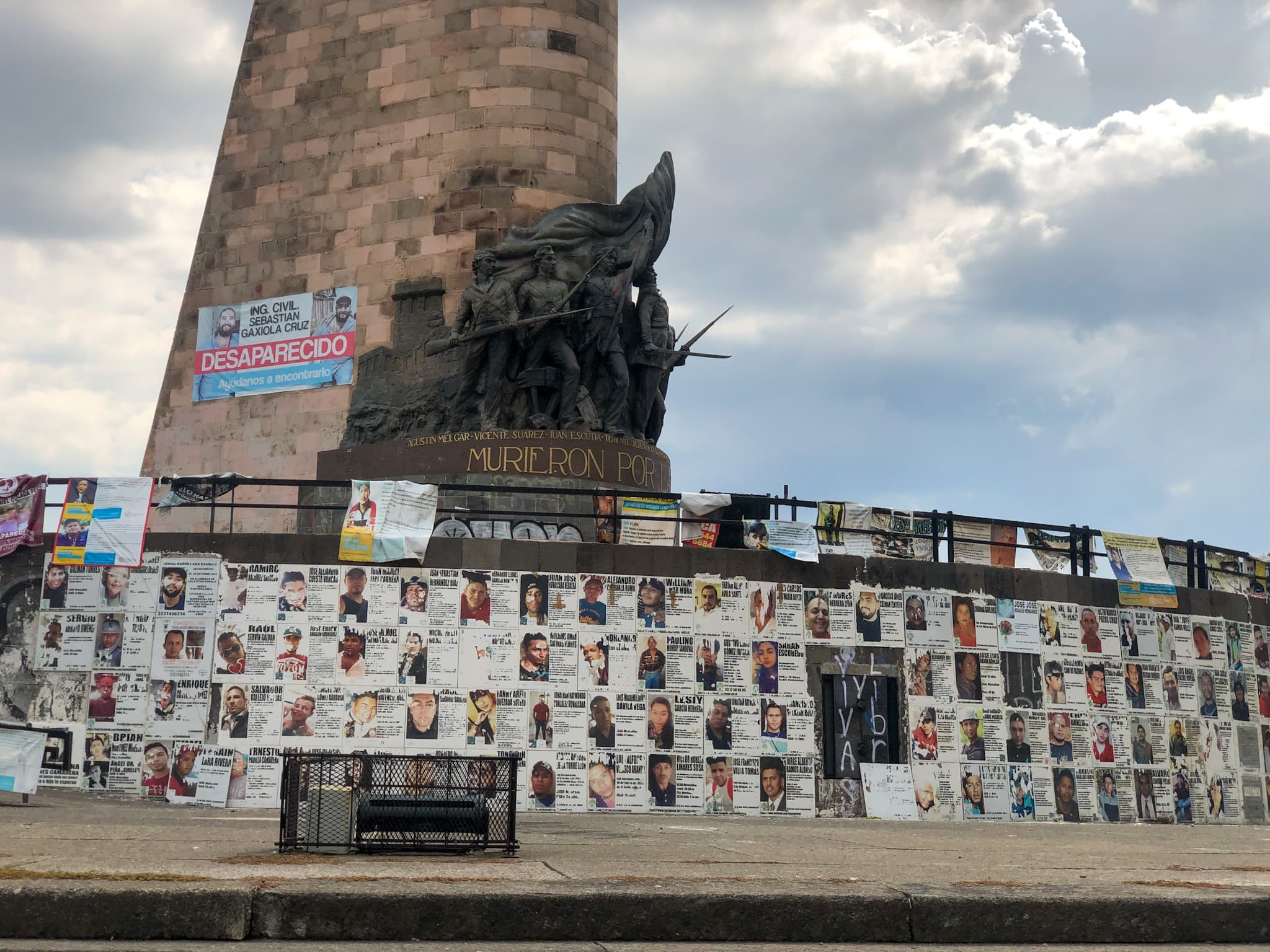
A case in point is the Interdisciplinary Group of Independent Experts (GIEI) — the team selected by the Inter-American Commission on Human Rights to investigate the events of Ayotzinapa — which, after more than eight years of research, suspended its activities last July. Though there were significant achievements for victims, the investigation into the forced disappearance of 43 students in Guerrero in 2014 has, ultimately, gone unsolved. Committed as the current government may have been to clarifying the events, state institutions — the Secretariat of National Defence in particular — were not fully transparent. The last report maintains that different branches of the state security apparatus had made false claims and withheld information. “Fue el Estado” (It was the state), the motto shouted by the parents of the disappeared students, and voiced by thousands of people across the globe, continues to be a perfect portrayal of a country that capable of neither truth nor justice.
The narco-state and the escalation of death
These facts do not attest to a failed or weak state but to the functioning of a perverse state in the service of capital accumulation where organised crime is a key actor that is growing in importance.
People in Mexico see the country as a narcoestado (narco-state), a two-way relationship whereby the state is infiltrated by organised crime and organised crime is enshrined in the state, rendering any differentiation between criminality and statehood very difficult. It is not only politics and economics that are criminally organised, the social and cultural realms are also negatively impacted. Everyday spaces are subjected to crime control — on public transport and in shops, for example — and the social fabric is being eroded. War is made a source of employment, and the idea of being a contender is turned into an ideal life, channelling discontent, transgressing local values, and shaping subjectivities through a logic of violence and the trivialisation of death. Though the current government has dropped the war rhetoric and embraced a campaign of “truth and justice”, these measures were taken to distract the public and to give the impression of genuine change. From day one, López Obrador has sought to control the media by performing the Mañaneras (4) every morning.

These morning conferences serve as a stage for constant attacks against the media and against journalists critical of his administration. In the same vein, the government created a section in the programme called “Who is who in the lies of the week” with a view to fighting “fake news”, exposing the media, and attaining the authority of absolute truth. It even published a list of public opinion leaders gathered according to the number of times they had expressed criticism of the president. This was not regular censorship, but it was threatening. Unsurprisingly, according to Reporters Without Borders, the country accounted for 20 percent of journalists killed worldwide in 2022, surpassing both Haiti and Ukraine. In addition, the mañaneras have become tools for disorientation, deceit, manipulation, propaganda, and sycophancy. A study conducted by the NGO, Signos Vitales, recorded AMLO as making an average of 80 false claims during each of these conferences, double the sum reached by the Washington Post’s analysis of Donald Trump. It is not only lies that are pervasive, there have also been insults and claims of illegitimacy made against women, academics, scientists, human rights organisations, or anyone who disagrees with his government. This means of criminalisation sees government opponents persecuted as “enemies of the national project” and creates an atmosphere of distrust, hostility, polarisation, and hatred.
The militarisation of extractive zones
Like so many others across the globe, this war attests to one thing: further accumulation, regardless of “how much blood and dirt is spilled”. Furthermore, this war on drugs gives accumulation processes a different shape and an increased pace. It speaks of a war economy of guns, drugs, and people, but also about the consolidation of extractivism and territorial control in a global capitalist economy. Territories are used to cultivate marihuana and poppies for opium cultivation as well as, more broadly, for the extraction of natural resources, such as minerals, hydrocarbons, wood, wildlife, and avocados. People are dispossessed of their land and forced, or seduced, to work in these industries while nature is degraded and devastated. Native peoples and rural communities are significantly impacted by this unceasing process of conquest. Meanwhile, foreign and national companies benefit from this lucrative commodity economy that is violently supported and protected by the narco-state.
Indeed, as has occurred with other progressive governments in the region, López Obrador's administration proposed the expansion of extractivism together with rent-redistribution programs for national development. The government hoped to use this combination to improve the living conditions of rural and native populations, “to look south and invest there”. A series of megaprojects were, thus, imposed on the population, mainly the so-called Maya Train, but also the Inter-Oceanic Corridor of the Isthmus of Tehuantepec, and the Morelos Integral Project. These projects entail the construction of infrastructure for the transit and production of energy, tourism, monocultures, real estate, minerals, and goods. This infrastructure is mainly associated with the promise of progress but also with extraction and violence, the embodiment, provocation or reinforcement of destruction, as well as surveillance and subjugation. The quite foreseeable consequences are, therefore, the devastation of ecosystems, the exacerbation of spatial segregation, inequality, violence, and the loss of ways of being and living for rural and native communities, to name just a few.
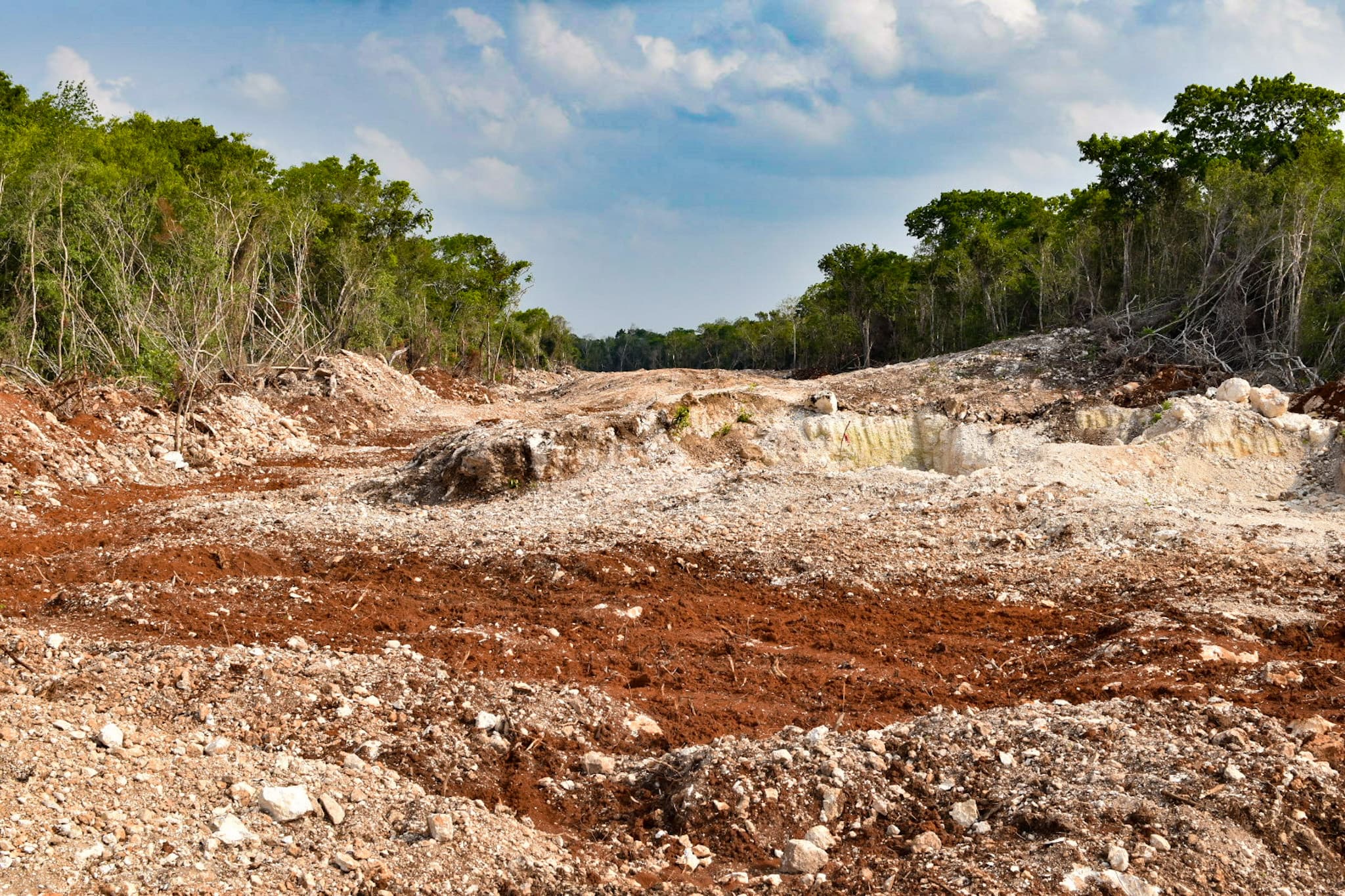
Beyond the exclusive use of clientelism and a rhetoric of national progress as a means of weakening and neutralising resistance, the government has also banked on the direct participation of the armed forces. The management and construction of these megaprojects is being carried out by the military, whose participation has been invoked via governmental decree as a matter of national interest and national security. The decision to do so was based on current levels of violence in the country as well as a desire to speed up procedures against judicial cases filed, in the words of López Obrador, by “pseudo-environmentalists financed by the US government”. However, it is possible to grasp the perversity in the relationship between the state and capital in this course of action, given that these projects are of economic significance for multiple reasons. For instance, the armed forces are responsible not only for having constructed the new airport in Mexico City, which they also currently manage, and for which they even purchased a commercial airline. They are also constructing six hotels and a casino in archaeological sites and natural reserves that will, as such, be subject to private ownership and profiteering.
There is a close relationship between the national security strategy and the consolidation of the extractive economy. In line with US interests, the militarisation of the country and the construction of megaprojects responds to the management of trade routes, flows of commodities, and the movement of peoples, such as Central Americans and Caribbeans towards the US. The current energy crisis, exacerbated by the war in Ukraine, is also relevant, given that these megaprojects are expected to relieve the increased energy demand and facilitate international trade. This spatial reordering crafted and operated by a local-global power network and by way of which the legal-illegal frontier is blurred, feeds the war machinery in Mexico. Actors at different levels work together to secure extractive projects and suppress any attempts at prevention, remaining indifferent to human rights violations. Indigenous peoples and land defenders, as well as activists, lawyers, and environmentalists, who put up resistance, are intimidated and repressed with threats, harassment, arbitrary detentions, legal cases, physical aggression, displacement, disappearance and murder.
According to Global Witness, three-quarters of the attacks against land and environmental defenders in 2021 occurred in Latin America. On a global scale, Mexico was responsible for the highest recorded number of murders, a trend that has been steadily on the rise. Though López Obrador has continuously claimed that his government will not use the armed forces to repress social struggles, the hostility, criminalisation, and defamation against them has been a preamble to such murders. Samir Flores Soberanes, defender of the territory against the Morelos Integral Project, was one of the first to suffer this fate. After breaking his promise not to construct a thermoelectric plant, López Obrador disqualified the opposition as “left-wing radicals who, to me, are nothing more than conservatives”. He then conducted a public consultation just three days after Samir was shot dead. While this was an alarming message for anyone who dared to speak out against megaprojects, public consultations manifested as a democratic façade facilitating access to territories.
Still, the South Resists
How do we deal with this situation? The Zapatista Army of National Liberation (EZLN) and the National Indigenous Congress (CNI), together with different organisations, collectives, communities, and individuals, have been organising to avoid being absorbed into this capitalist war and its multiple effects. They have been walking a struggle for life, each in their own way and in their own time. Some conduct research and disseminate information to unveil the reality, others protest proyectos de muerte (projects of death), others arm themselves to protect their communities while others use the legal system to defend their own rights and those of nature itself. They also share, dance, sing, sew, cook, and live together. In 2022, a group of Zapatistas toured Europe with members of the CNI in what they have referred to as a Journey for Life, by way of which different territories are woven together to strengthen the struggle against the pains of the world. Some of the rebels in Europe then decided to come to Mexico and accompany diverse projects, among them the Caravan El Sur Resiste (The South Resists).
From April 25 until May 4, 2023, individuals and collectives from different parts of Germany, Greece, Italy, France, and Spain, among others, visited 11 localities in the states of Chiapas, Oaxaca, Veracruz, Tabasco, Campeche, Yucatan, and Quintana Roo. The objective was to listen, see, make visible, and inform people about the destruction of the region in which the interconnected projects — the Interoceanic Corridor and the Maya Train — are currently under construction. En route, the caravan mourned the destruction of the rainforest, raged over the military construction of a post in a natural reserve, witnessed the alteration of a river course, corroborated the attempts of industrial parks to dispossess the rightful inhabitants, and recoiled at the sight of a fishing community swallowed by the sea. It also saw the desire and support of a large part of the communities for the trains, witnessing the lack of community organisation that occurs either because of misinformation, fake promises, fear, or co-option. The caravan also experienced increased militarisation and harassment by way of photographing, surveillance, and constant stops. Yet it rose up after state forces violently evicted the encampment Tierra y Libertad, preventing the modernisation of the train tracks in Mogoñé Viejo, Oaxaca.
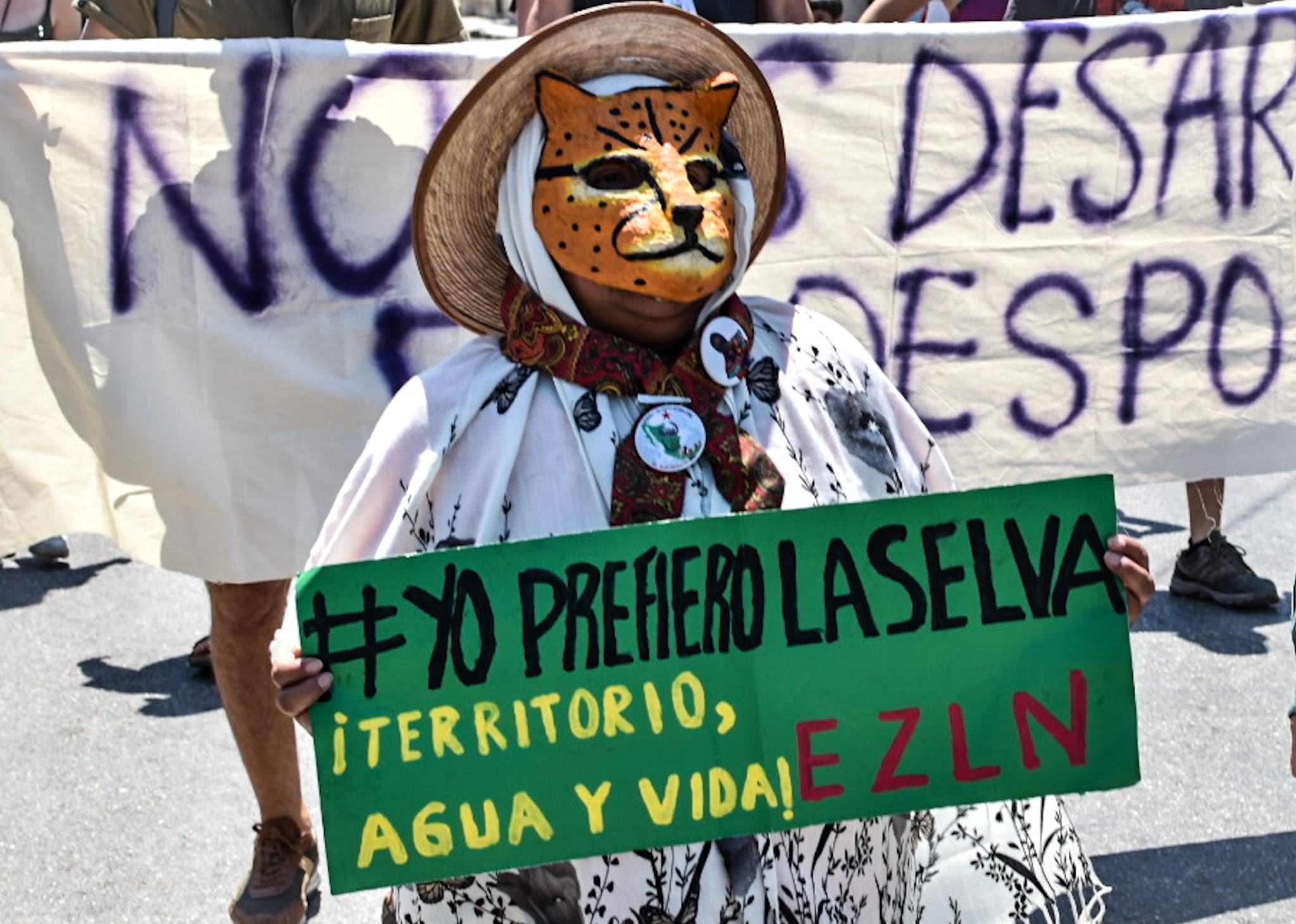
While the president denies that there are blockades against the projects, the caravan experienced first-hand the resistance against mining, wind and solar farms, monocultures, train tracks, and industrial parks. All along the road, companies, state institutions, and organised crime were all outlined as allies in the installation of these projects. Still, the spaces that were visited have demonstrated more autonomous ways of living such as community health centres, radios, education projects, agroecological crops, rebel art, and music. Furthermore, in the following days, more than 900 hundred persons, including representatives of 40 native peoples, land defenders, and activists from 30 countries and 10 autonomous regions, gathered in an international meeting in Chiapas. Resistance movements are building bridges to develop support networks, strengthen opposition, radiate alternative projects, and keep anti-capitalist creativity alive.
Chiapas is Mexico
In Chiapas, the Zapatista communities that have inspired numerous struggles worldwide, and who promote transnational solidarity, have resisted low-intensity warfare for 30 years. Paramilitaries with links to the armed forces and financed/permitted by various state actors have sought to destroy the autonomous life achieved by the Zapatistas. Their territory has presented an obstacle to expanding extractivism and organised crime, both of which have responded by perpetuating attacks and spreading terror. Under López Obrador's administration, the war in Chiapas has also intensified. Not only are paramilitary groups still in operation, they are now more active than before. A statement from the Centre for Human Rights Fray Bartolomé de Las Casas revealed that there have been more than 110 armed attacks against Zapatista communities, including “the burning of schools and coffee warehouses, armed assaults, torture, kidnappings, and serious gunshot wounds”. This counterinsurgent strategy is converting the region into another face of the endless war. As the Zapatistas put it:
"Civilisation seems to be telling the originary peoples: ‘the proof of your underdevelopment is evident in your low rate of femicides. Here you go, here are your megaprojects, your trains, your thermoelectric plants, your mines, your dams, your shopping centers, your home electronics stores—television channel included. Learn to consume. Be like us. To pay back the debt of this progressive aid we’re offering, your lands, waters, cultures, and dignity won’t quite be enough—you’re going to have to throw in the lives of women."
Chiapas is on the border with Guatemala and is, thus, of strategic geographical importance for the traffic of drugs, people, and arms. But it is also rich in natural resources such as minerals (e.g., titanium and baryte), water, wood, gas, and oil. Though the Maya Train will cross the state only partially, the expansion of extractivism facilitated by the train will have an enormous impact. In point of fact, the dispute for territorial, economic, political, and social control of the area has led to alliances between corporations, the state, and paramilitary groups who have been neutralising resistance and opening the path for extractivist industries. In 2021, the Zapatistas issued a communiqué warning the public that Chiapas was on the verge of civil war given the state government’s protection of cartels and its encouragement of paramilitary groups. At the same time, communities were being forced to create self-defence groups, causing more disputes, clashes, and confrontations. They also warned that if the violent situation persisted, there would be no further words, only actions.
As of December 2021, the Zapatistas have remained silent. On May 22 of this year, a paramilitary group attacked the Moisés Gandhi Zapatista community, seriously injuring one EZLN member. People throughout Mexico and throughout the world mobilised in response to the increased violence, demanding an end to the war in Chiapas and in the country as a whole. It was not the first time that a variety of collectives demonstrated in favour of this objective. In October 2022, the phrase “No militarisation” was shouted by mothers, students, native peoples, parents of the disappeared Ayotzinapa students, feminists, environmentalists, artists, scholars, and others demanding an end to the violence against people and nature, and an end all capitalist wars worldwide. This June, there were even more extensive protests, with the CNI registering 72 protests, 36 nationally and 36 internationally.
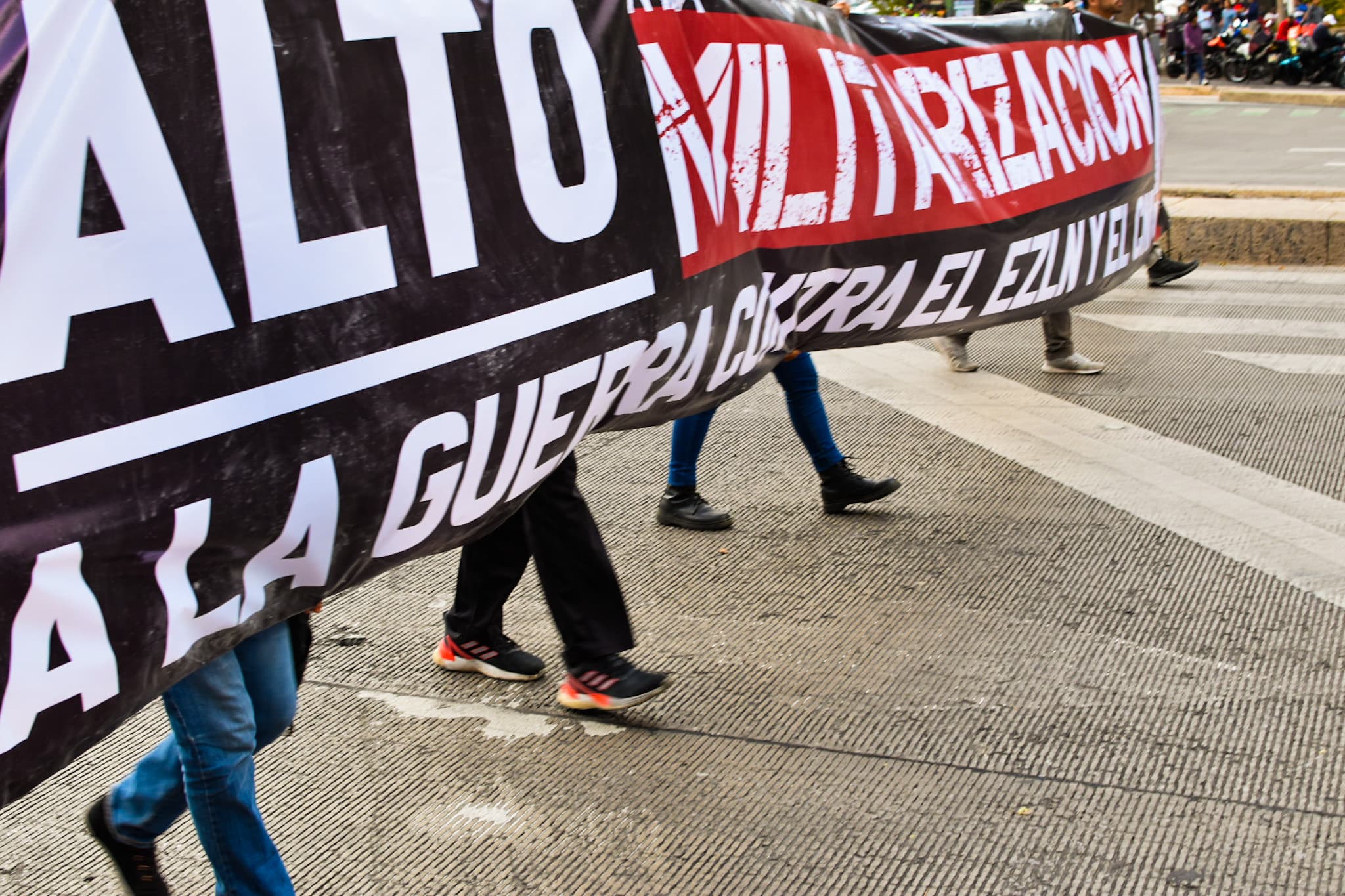
There has been an outpour of solidary as this war has immersed the country in blood, endangering one clear example of anti-capitalist living, dealing a severe blow to our creativity and hopes for another world. For many years, the Zapatistas have accompanied and served as allies with different movements worldwide. This time around, they are being shown by thousands of people that they are not alone. They know that Chiapas is just a mirror of what is happening in other parts of Mexico, the same violence, the same pain, the same death: Chiapas is Mexico. Despite all efforts at resistance, paramilitary attacks against three Zapatista communities have continued. As with the rest of the country, the situation in Chiapas is being masked and rendered invisible. The state remains silent and unresponsive. López Obrador even downplayed the severity of the situation, maintaining disqualifications against organisations and activists. Meanwhile, society is continuing to mobilise peacefully against denialism, denouncing the war and state complicity, while organising solidarity to end the war.
López Obrador became president of a country overwhelmed by violence. Yet his arrival has not served to stop the war but rather to prevent a crash in the country’s own brand of sadistic, exploitative, and extractivist capitalist governability. The new president has opted for an authoritarian stance, consolidating the militarisation of everyday life and a policy of war against people and nature that will be hard to reverse. Justified as a means of bringing peace and development to the country, the Mexican state prolongs an atrocious war with a view to reorganising society, reconfiguring territories and protecting a global criminal economy that currently faces a polycrisis. The events described are diverse manifestations of a capitalist war that the current government tolerates and promotes in alliance with various local and global, legal, and illegal actors. Still, voices from near and far that live in pain and rage at the decomposition of the world and the annihilation of the planet will continue to cry out demanding that we neither forget, nor lose hope and dignity, that we keep struggling for Life.
Footnotes:
1. 152 politicians were assassinated, while 774 acts of aggression were registered; see https://www.rompeviento.tv/152-politicos-asesinados-en-las-elecciones-2018-una-de-las-mas-violentas-de-mexico/
2. The data reported was current at the end of 2022.
3. According to Human Rights Watch, levels of impunity in Mexico are so high that little more than one percent of all crimes are solved; see: https://www.hrw.org/world-report/2023/country-chapters/mexico
4. Presidential press briefings held every weekday at 07:00.

